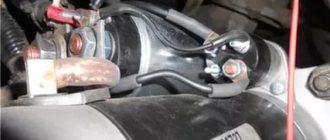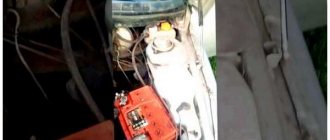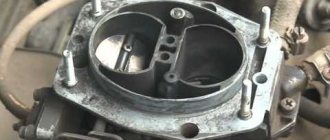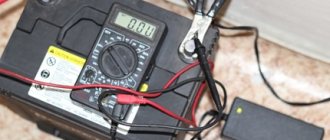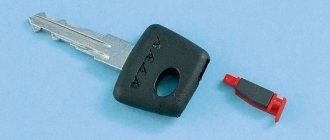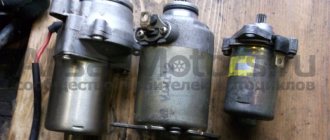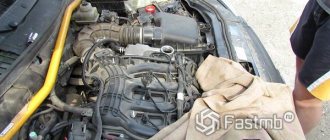What does the contact ignition system of VAZ cars consist of?
As you know, long-term and uninterrupted operation of the internal combustion engine of any car depends on many factors:
- operating conditions of the power unit and load;
- quality of fuel and lubricants;
- operation of the power system;
- proper operation of ignition systems, etc.
As for ignition, the contact ignition system is structurally simple, inexpensive to maintain, reliable and efficient. Main components using the example of VAZ 2106:
- distributor VAZ 2106;
- mechanical drive of VAZ 2106 distributor;
- high voltage wires;
- spark plug.
Checking explosive wires and spark plugs of VAZ 2106
The wire can be checked by measuring its resistance. At a minimum, there must be some resistance in the wire. As a maximum, it should not be too large, i.e. resistance in the range of 0.3 - 0.5 kOhm will be normal. If the tester shows nothing, i.e. a break means that the wire is not working and needs to be replaced. You can also check the wire by swapping it with a wire from another working cylinder.
The spark plug should have a normal gap of 0.7-0.8 mm. The candle must be clean - not in oil, not in black soot. An ideal candle has a slightly brownish coating. (More about spark plugs here) But naturally, if you unscrew a spark plug from a non-working cylinder, it will be clogged. Such a candle can be heated over an open fire so that all the deposits burn out and try to be installed in the engine. To be 100% sure that the problem is not in the spark plug, it is better to install a new or known working spark plug. If the problem does not go away, then we check further.
Spark plug
If there is no spark, or a weak spark is observed, the first element that the car owner pays attention to is the spark plugs. You need to check whether one of the candles has stopped working. First, check to see if the candles have turned black. In this case, they require mandatory replacement.
The test can be carried out under any conditions. Even right on the road in case of an unexpected breakdown. It is important to have a set of working candles with you in stock for such a case.
- install a new spark plug
- turn the starter and see if there is a spark
- If everything works properly, we start the engine and move on.
Sometimes installing a new working spark plug does not help - there is still no spark. In this case, you need to start checking the following elements of the system to find out why there is still no spark.
Symptoms of a problem
Adjusting the ignition on a car is required after repairing the engine or removing the distributor. Like any mechanical system, it tends to wear out, and characteristic symptoms appear:
- The engine does not start or runs intermittently. If gasoline enters the carburetor, the reason lies in incorrect setting of the ignition angle or misalignment of the marks on the timing chain.
- Reduced acceleration dynamics and deterioration of motor elasticity. The mixture does not ignite at the optimal time, so efficiency decreases.
- Increased fuel consumption. This happens with late ignition, when in order to obtain the same dynamics you have to press the gas pedal more actively. Some of the gasoline does not have time to burn and flies out into the exhaust pipe.
- Late ignition causes a popping sound in the muffler when the unburnt fuel mixture ignites when the exhaust valve opens.
- Rough operation of the engine is possible with early ignition of gasoline in the cylinders. An explosion at the moment the piston does not reach TDC is the cause of the characteristic rattling sound and ringing.
Attention! Late ignition often causes burnout of the exhaust valves, which at this moment overheat.
Having discovered a malfunction, you should check whether the ignition is installed correctly on the VAZ 2106, and if necessary, adjust it. To work, you will need a spark plug wrench, a “13” wrench, a light bulb or strobe light, and a plate probe.
Article on the topic: How long does alcohol stay in a person’s blood?
Checking the gasoline supply
You can indirectly determine the supply of gasoline to the cylinders by the appearance of the spark plug. If the spark plug removed from the cylinder is wet and smells of gasoline, then everything is fine with the fuel supply. However, it is better to make sure of this more reliably.
On injection engines, this requires relieving pressure in the fuel system using a special valve at the end of the fuel rail. Unscrew the cap and press the valve with a screwdriver. Gasoline should squirt out from under the valve. After this, release the valve and turn on the ignition. At this time, the fuel pump must start, restoring the released pressure in the system. If the pump is silent, turn on the starter. When the pump does not operate even when the starter is turned on, there is most likely a malfunction in its power supply system.
If the pump starts working, then we check the pressure in the fuel system again, releasing it through the same valve in the ramp. Splashing gasoline again indicates that everything is in order with the fuel supply system. When gasoline does not splash and does not appear from under the valve at all, we can talk about a faulty fuel pressure regulator in the rail (constantly bleeds gasoline through the return line into the tank) or some kind of plug in the main fuel line (for example, due to freezing of water in low-quality fuel ).
On carburetor engines, checking the fuel supply is much easier. It is enough to remove the air filter cover, move the throttle lever of the first chamber of the carburetor, simulating pressing the gas pedal, and see if gasoline sprays from the spray nozzle. You can pump gasoline into the carburetor using the manual pumping lever, which is found on all mechanical gasoline pumps.
Checking compression of VAZ 2106
Further, if the engine is stalling, it would be a good idea to check the compression of the idle cylinder, since its absence may be the cause of the engine stalling. How to check compression? To do this you will need a compression gauge and the help of your friend. (Compression measurement process) Compression in a new engine should be within 12 points. If the compression in an idle cylinder is less than 8 points, then this is what can cause the engine to trip. If the compression is 9-10, then you should measure it in all other cylinders. The compression in all cylinders must be +- the same and its difference by more than 1 point is unacceptable.
The starter turns, but the engine does not start
This kind of trouble usually happens due to a broken timing belt. It is this element of the VAZ-2106 that the owner needs to look at first of all. If suspicions are confirmed, then it will have to be replaced with a new one. When the belt is intact, then look further - the reason may be a faulty spark plug or fuel pump.
Check it like this:
- activate the ignition;
- wait until the starter rotates 7-10 times;
- Unscrew and inspect the spark plugs.
When they remain completely dry, this means that gasoline is not entering the combustion chamber, and, therefore, the pump is to blame. Confirm your guess - turn on the ignition again and listen: the functioning pump makes a characteristic hum. Silence indicates a node failure - change it.
The pump on 2106 hums, fuel flows, but the car does not start. Do this:
- touch the spark plug to the engine body;
- ask someone to turn on the ignition;
- If there is no spark, change the entire set.
Checking the performance of the power system
If your car won't start, we suggest starting with diagnosing the power system. It is quite possible to do it yourself. This requires:
- open the air filter;
- pour about 10 milligrams of gasoline directly into the carburetor;
- turn the ignition key. If the car starts and immediately stalls, it means that there is a serious problem in the fuel supply to the power unit;
- remove the clamp that tightens the hose connected to the carburetor;
- lower the other end of the hose into a container. Best of all - in a transparent bottle;
- press the fuel pump lever to see if fuel is supplied to the carburetor. If the result is negative, we repair the power system.
Most often, in this very system, the fuel pump fails, which is very sensitive to low-quality fuel. Special filters provide its protection, but over time, the filter elements become clogged and substances enter the pump that negatively affect its operation.
If this is the case, you will need to dismantle the device, thoroughly clean it, install new filters, and only then carry out installation.
Another problem with the fuel pump is air getting into it. To eliminate this problem, you need to very carefully check the entire line, and then eliminate any leaks found.
Ignition distributor contacts
We proceed to this step only after we have completed the previous two to no avail.
You need to open the ignition distributor cap. We very carefully visually assess whether carbon deposits have appeared on the contacts. If such a problem is present, use a knife to very carefully remove this deposit.
You can also check whether the contacts are working properly. To do this, without closing the lid, turn the starter and see if all contacts open. If some contacts do not work correctly, you will have to adjust the required gap in the spark plugs on the VAZ 2106.
Checking the spark plugs and spark
If the engine does not start within five seconds, there is no use turning the starter. You can try to start it again, but it’s unlikely to help. Moreover, operating the starter for too long can lead to overheating and even fire.
If you try to start a carburetor engine for a long time, gasoline will flood the spark plugs and make further starting attempts impossible in principle. The injectors have a purge mode, so the spark plugs can be dried without removing them from the car - you just need to press the gas pedal to the floor and turn the starter.
But these are half measures. First of all, you should unscrew at least one spark plug, put the wire back on it and position the spark plug on the engine so that there is a distance of about three millimeters between the metal part of the spark plug and the metal of the engine. Turn on the starter and make sure that there is a uniform spark between the spark plug contacts. Do this check for each candle. If there is no spark on any spark plug, then there are global problems in the ignition system.
It can be:
General faults:
- Faulty spark plugs (carbon deposits, destruction of insulator)
- The high-voltage wires are faulty (the insulation is broken, the current flows “to the left”, not reaching the spark plug)
For injectors:
- Ignition module is faulty
- There is no power to the ignition module. Power is supplied from the engine control unit, but the signal to the unit comes from the ignition switch. Therefore, there may be a malfunction of the ignition switch contact group.
- Engine control unit faulty
Errors in the ignition control system are usually visible during diagnostics and cause the Check Engine light to turn on.
For carburetors:
- Contact carbon stuck in the ignition distributor cap (distributor)
- Resistor burnout in the distributor rotor (in the distributor runner)
- Burning or play of the contact group (for contact ignition)
- Switch malfunction (for contactless ignition)
- Ignition coil malfunction
- No power to the coil. Power is supplied to the coil through the ignition switch, so it is worth checking its contact group
When there is no spark on only one spark plug, you need to replace this spark plug with a new one or change its high-voltage wire. Spark plugs that are too wet should also be replaced with new ones or at least dried in a flame. This is necessary because current will not be able to pass through wet contacts and there will be no spark.
If there is a spark on all spark plugs, check the fuel supply.
Starter does not turn
When starting the engine, the starter does not rotate. There are several reasons, here are some of them:
- The battery is dead. To check, you need to measure the voltage with a load plug with double load relative to the battery capacity; it should not drop below 9 volts. If there is none, you can tell by the headlights, turn them on and look at them. A bright glow means everything is fine, a dim glow or no light means the battery is dead. To resolve this, you need to charge the battery using a charger.
- There is no contact at the DC power supply terminals. This may have happened due to oxide coating on one of the terminals. In this case, the headlights and instrument panel lights will glow normally, but there will not be enough current to power the starter. To check, you need to lift the hood and inspect the battery, or rather the terminals. They will have a coating similar to snow. The fix is simple: disconnect the terminals, clean the terminals from oxide on the wires and battery with sandpaper, wipe with a rag, lightly apply lithol to the contact surfaces of the terminals (will protect against oxidation), install them in place and screw them tightly.
- The ignition switch is broken. Checking is as easy as shelling pears: disconnect the wires that go to start from the lock terminals, connect them together. If the starter turns over, then the problem is in the lock. It can only be eliminated by replacement, since this unit in Zhiguli cannot be repaired.
- The starter solenoid relay is broken. This breakdown is recognizable by its characteristic features. When trying to start the engine, a clicking sound is made somewhere in the engine compartment, but the starter does not rotate. It is worth additionally checking whether the relay has failed or not. To do this, take a small insulated conductor and connect the terminals on the starter relay, those with large nuts (there are two of them). If the starter shaft rotates, then the relay is not working. It should be replaced. It is better to do this in workshops where there is the necessary special equipment.
- The armature winding on the starter burned out. Or the motor brushes are worn out. In these cases, when you try to start, the starter will not make any clicks. To determine the cause, the unit will have to be removed and diagnosed. If wear of the brushes is confirmed, they can be replaced, this is not difficult, but if there is an interturn short circuit, then the starter needs to be changed.
How to check it?
For this we need a multimeter. We measure the resistance of the crankshaft sensor coil. It should be between 500 and 700 ohms. On the multimeter itself, we set the limit to 200 millivolts and attach the probes to the sensor outputs.
We pass a steel object several times in front of the core. If the element is working, it should recognize it, and the multimeter will show the readings described above. If there are none, the sensor has become unusable. It cannot be repaired - only replaced.
Ignition adjustment of VAZ 2106: preparatory work
If malfunctions occur in the operation of the ignition system, it becomes necessary to adjust it. It is possible to adjust the ignition system either independently or in specialized service centers.
To accurately adjust the ignition, you need a strobe device, which allows you to adjust the car’s ignition in such a way that the internal combustion engine power is maximum, fuel consumption is minimal, and emissions into the atmosphere are within the permissible limits.
How to set the ignition on a VAZ 2106 with your own hands
For independent work on adjusting contact ignition, you will need the following tools and equipment:
- socket wrench set to “13”;
- voltmeter or 12 volt test light;
- spark plug wrench (for installing and removing spark plugs of a car’s internal combustion engine).
The adjustment is carried out on the first or fourth cylinder. Please note that on the VAZ 2106, the ignition is set using marks located on the gas distribution mechanism cover (short - advance angle 10°, medium - advance angle 5°, long - advance angle 0°).
So, in order to understand how to set the ignition on a VAZ 2106 yourself, you need to study the procedure for performing the work. Let's look at how to set the ignition of a VAZ 2106 to the first cylinder:
- Having unscrewed the spark plug of the first cylinder, close the spark plug hole with a rubber plug;
- using a spanner wrench, turn the crankshaft to the compression stroke position in the first cylinder (the rubber plug will be squeezed out);
- continue to turn the crankshaft until its mark coincides with the mark on the timing belt (the middle mark is fuel grade “92” or “95”, the long mark is fuel grade below “72”);
- Unfasten the latches and remove the ignition distributor cover;
when the crankshaft is rotated correctly, the distributor rotor will be rotated to a position in which its outer contact will be directed towards the first cylinder on the distributor cap (when the marks of the cover latches are aligned relative to the internal combustion engine, they should be parallel);
- we connect the wires of the voltmeter or control light to the terminal of the ignition coil connected to the low-voltage wire of the distributor and to ground;
- Having turned on the ignition, you need to slowly turn the distributor clockwise until the lamp goes out or until the voltmeter shows zero;
- rotating the distributor counterclockwise until the lamp lights up, fix it in this position by tightening the fastening nut;
- Turning off the ignition, put the distributor cap back in place;
- using a special strobe device, check whether the ignition is set correctly;
- Also, while driving, you need to make sure that the detonation that occurs disappears as the car accelerates.
Possible causes of failure
If you classify all the faults due to which the engine does not want to start, you will get only two categories:
- problems in the fuel system;
- ignition system malfunction.
In most cases, a professional can identify the problem right away. Each malfunction is accompanied by a certain “behavior” of the motor. For most motorists, the engine simply won't start.
Here are some signs by which you can identify a malfunction, so as not to try to “repair” a working part or assembly without reason.
No spark or weak spark
If the VAZ 2107 engine does not start, the first thing you need to pay attention to is whether there is a spark, and if there is, whether it is powerful enough to ignite the air-fuel mixture. To determine this, you should check:
- spark plug;
- high voltage wires;
- distributor;
- ignition coil;
- voltage switch (for contactless ignition) and Hall sensor;
- crankshaft position sensor.
Spark plug
They are checked as follows:
- you need to unscrew one candle and put a candle holder on it;
- lean the side electrode against the cylinder head;
- the assistant begins to crank the starter;
- A quality spark should be thick and blue in color. In case of a red spark or its absence, the spark plug should be replaced with a new one. If replacing a separate spark plug does not solve the problem of lack of spark, then you need to look for the cause in other elements of the system.
This way all four spark plugs are checked. If there is no spark on one or more cylinders and replacing the spark plugs does not solve the problem, you need to check the next element - the high-voltage wires.
High voltage wires
Before you go to the store for new wires, it is important to make sure that the problem really lies with them. To do this, unscrew the spark plug that had the spark, and put the wire of the inoperative cylinder on it. If a spark does not appear when turning the starter, then a worker from the adjacent cylinder is installed in place of this wire.
The appearance of a spark indicates a malfunction of a separate high-voltage cable. It can be solved by replacing the cable set. If the discharge does not appear, then the central wire is checked. The procedure is identical - the candle holder is put on the working spark plug, which is leaned against the “ground” with the side electrode (the distance between the contact and the head body should be approximately a millimeter). Cranking the starter should produce a spark. If it is, the problem is in the distributor; if not, the problem is in the ignition coil.
There are often cases when in wet weather (heavy fog) the car does not start even with the ideal ignition system settings. You should pay attention to the explosive wires. Sometimes the problem occurs because they are wet. You can roll the car around the yard all day (to start the engine), but until the wet wires are wiped dry, nothing will work.
When working with high-voltage wires, it is important to remember: the voltage in them is very high, so you need to hold them not with your bare hands, but with well-insulated pliers.
Distributor
If checking the spark plugs and high-voltage wires did not give the desired result (but there is a spark on the central wire), then the problem can be looked for in the contacts of the ignition distributor cap.
It is removed and checked to see if there are any cracks or carbon deposits on the contacts. If they are slightly burnt, they must be carefully cleaned (you can use a knife).
Additionally, contact “K” is checked. If there is no voltage to it, the problem may be with the ignition switch, power wire, or fuse. The gaps at the breaker contacts are also checked (0.4 mm probe) and the serviceability of the resistor in the slider.
Ignition coil
The easiest way to check a possible coil malfunction is to install a working one. If a multimeter is available, the diagnostics should show the following results:
- For the B-117 coil, the resistance of the primary winding should be from 3 to 3.5 Ohms. Resistance in the secondary winding is from 7.4 to 9.2 kOhm.
- For a coil of type 27.3705 on the primary winding the indicator should be in the range of 0.45-0.5 Ohm. The secondary should show 5 kOhm. In case of deviations from these indicators, the part must be replaced.
Voltage switch and Hall sensor
The easiest way to check the switch is by replacing it with a working one. If this is not possible, then you can perform the following procedure.
The wire running from the commutator to the coil is disconnected from the coil. A 12-volt light bulb is connected to it. Another wire is connected to the other contact of the lamp to connect the “control” to the coil. It should flash when cranked by the starter. If there are no “signs of life”, then you need to replace the switch.
Sometimes the Hall sensor on a VAZ 2107 fails. Ideally, it would be good to have a spare sensor. If it is not there, then you will need a multimeter. At the output contacts of the sensor, the device should show a voltage of 0.4-11 V. If the indicator is incorrect, it must be replaced.
Crankshaft position sensor
This part plays a major role in the process of spark formation in the ignition system. The sensor detects the position of the crankshaft when the piston of the first cylinder is at top dead center on the compression stroke. At this moment, an impulse is formed in it, going to the ignition coil.
If the sensor is faulty, this signal is not generated, and, as a result, a spark does not occur. You can check the sensor by replacing it with a working one. It is worth noting that this problem is less common, and in most cases, if there is no spark, it does not come to replacing it.
Experienced motorists can determine a specific breakdown by how the car behaves. Various problems when starting the engine have their own characteristic symptoms. Here are common problems and their manifestations when starting an internal combustion engine.
The starter turns - no flashes
Such behavior of the engine may indicate a broken timing belt. Often this problem entails replacing valves, since not all modifications of internal combustion engines have pistons with recesses that prevent deformation of the open valve when reaching top dead center.
For this reason, the timing belt replacement regulations must be followed. If it is in order, then the ignition and fuel supply system is diagnosed.
- Fuel system. After cranking the starter, the spark plug is unscrewed. If its contact is dry, it means that no fuel is entering the working chamber. The first thing you need to check is the fuel pump. In injection engines, the malfunction of this part is determined by the absence of a characteristic sound after turning on the ignition. The carburetor model is equipped with another modification of the fuel pump (its design and repair options can be found in a separate article).
- Ignition system. If the unscrewed spark plug is wet, it means fuel flows in but does not ignite. In this case, it is necessary to carry out the diagnostic procedures described above to identify the malfunction of a specific part of the system.
The starter turns, engages, but does not start
On a VAZ 2107 injection engine, this behavior is typical when the Hall sensor is faulty or the DPKV is unstable. They can be checked by installing a working sensor.
If the engine is carburetor, then this happens when the spark plugs are flooded. Often this is not a problem with the car, but the result of improper starting of the engine. The driver pulls the choke cable and presses the accelerator pedal several times. Too much fuel does not have time to ignite, and the electrodes flood. If this happens, you need to unscrew the spark plugs, dry them and repeat the procedure, after removing the suction.
In addition to these factors, the reason for this behavior of the motor may be the spark plugs themselves or high-voltage wires.
Starts and stalls immediately
This problem may be a consequence of a problem with the fuel system. Possible reasons include:
- lack of gasoline;
- poor fuel quality;
- failure of explosive wires or spark plugs.
If the above factors are eliminated, then you should pay attention to the fine fuel filter. Due to the poor quality of gasoline and the presence of a large number of foreign particles in the gas tank, this element can become dirty much faster than the time comes to change it according to the maintenance regulations. A clogged fuel filter cannot filter gasoline at the same speed as the fuel pump pumps, so a small amount of fuel enters the working chamber, and the engine cannot operate stably.
When errors appear in the electronic control unit of the injection “seven”, this can also affect the engine starting. This problem is best diagnosed at a service station.
The carburetor power unit may stall due to clogging of the mesh filter element, which is installed at the inlet of the carburetor. It is enough to remove it and clean it with a toothbrush and acetone (or gasoline).
Doesn't start when cold
If the car is idle for a long time, gasoline from the fuel line returns to the tank, and the one in the carburetor float chamber evaporates. To start the car, you need to pull out the choke (this cable regulates the position of the damper, which shuts off the air supply and increases the amount of gasoline entering the carburetor).
In order not to waste battery power by pumping fuel from the gas tank, you can use the manual pumping lever located on the back of the gas pump. This will help in cases where the battery is almost discharged and you cannot turn the starter for a long time.
In addition to the peculiarities of the fuel system of the carburetor "seven", the problem of cold starting may be a violation of spark formation (either it is weak or does not occur at all). Then you should check the ignition system using the methods described above.
Doesn't start when hot
A problem of this type can occur on both carburetor and injection VAZ 2107. In the first case, the problem may be as follows. While the engine is running, the carburetor becomes very cool due to the fact that cool air constantly enters it. As soon as the hot engine is turned off, the carburetor stops cooling.
In a matter of minutes, its temperature becomes the same as that of the power unit. The gasoline in the float chamber evaporates quickly. Since all the voids are filled with gasoline vapors, restarting the engine (5-30 minutes after turning off the ignition) after a long trip will result in a mixture of gasoline and its vapors entering the cylinders. Since there is no air, no ignition occurs. In such a situation, the candles simply flood.
The problem is solved in the following way. When cranking the starter, the driver fully depresses the gas pedal so that the vapors quickly leave the carburetor and it is filled with a fresh portion of air. Do not press the accelerator several times - this is a guarantee that the spark plugs will flood.
On carburetor classics in the summer, sometimes the fuel pump cannot withstand intense heat and fails.
The injection “seven” may have difficulty starting a hot engine due to a breakdown:
- crankshaft sensor;
- coolant temperature sensor;
- air flow sensor;
- idle speed controller;
- gasoline pressure regulator;
- fuel injector (or injectors);
- fuel pump;
- in case of malfunction of the ignition module.
In this case, the problem is much more difficult to find, so if it occurs, computer diagnostics will be required, which will show which specific node is failing.
Won't start, shoots into the carburetor
This problem has many causes. It is impossible to say for sure what malfunction leads to this. Here are some of them:
- High voltage wires are not connected correctly. This rarely happens because in most cases each of them has its own length. If the car owner accidentally mixes up the order of their connection, this leads to the formation of a spark not at the moment when the piston is at top dead center on the compression stroke. As a result, the cylinders try to operate in a mode that does not correspond to the settings of the gas distribution mechanism.
- Such pops may indicate early ignition. This is the process of igniting the air/fuel mixture before the piston reaches top dead center, completing the compression stroke.
- A change in the ignition timing (earlier or later) indicates some malfunction of the distributor. This mechanism distributes the timing of the spark supply to the cylinder during the compression stroke. In some cases it is necessary to check its fastening. Pre-ignition is eliminated if you turn the distributor in accordance with the marks on the scale.
- Sometimes such failures indicate a failure of the ignition system switch. In this case, it should be replaced with a new one.
- During car repairs, the timing belt (or chain) has become misaligned, causing the camshaft to distribute phases incorrectly. Depending on its displacement, the engine will either work unstably or not start at all. Sometimes such an oversight can lead to expensive work to replace bent valves.
- A lean fuel-air mixture can also lead to shooting in the carburetor. The cause of this problem may be clogged carburetor jets. It's also worth checking the accelerator pump. Incorrect position of the float in the float chamber may cause insufficient gasoline level. In this case, you can check whether the float is adjusted correctly.
- Valves burnt out or bent. This problem can be identified by measuring compression. If the intake valve does not completely close the hole (burnt out or bent), then excess pressure in the working chamber will partially escape into the intake manifold.
Won't start, fires in the muffler
Popping noises in the exhaust manifold often occur as a result of late ignition. In this case, the air-fuel mixture ignites after the piston completes the compression stroke and begins its power stroke. At the moment of the exhaust stroke, the mixture has not yet burned out, which is why shots are heard in the exhaust system.
In addition to setting the ignition timing, you should check:
- Thermal clearance of valves. They must close tightly so that during compression of the fuel-air mixture it remains in the combustion chamber of the cylinder and does not enter the exhaust manifold.
- Is the gas distribution mechanism set correctly? Otherwise, the camshaft will open and close the intake/exhaust valves not in accordance with the strokes that are performed in the cylinders.
Incorrectly set ignition and unadjusted valve clearance will eventually lead to engine overheating, as well as burnout of the manifold and valves.
The injection seven may suffer from similar problems. In addition to failures, poor contact or failure of one of the sensors on which stable operation of the motor depends can result. In this case, diagnostics will be required, since there are many locations for troubleshooting.
The starter does not work or turns sluggishly
This problem is a frequent companion of inattentive motorists. Leaving the light on overnight will completely drain the battery. In this case, the problem will be immediately noticeable - the equipment will also not work. When you turn the key in the ignition, the starter will make clicking noises or slowly try to turn over. This is a sign of a low battery.
The problem of a discharged battery is solved by recharging it. If you need to drive and don’t have time for this procedure, then you can start the car using a pushrod. A couple more tips on how to start a VAZ 2107 if the battery is dead are described in a separate article.
If the driver is attentive and does not leave the equipment turned on at night, then a sudden disappearance of energy may indicate that the battery contact has oxidized or fallen off.
How to set Contactless Ignition on a VAZ 2106
Introduction of electric ignition on the VAZ 2106
Every owner of the famous traditional VAZ 2106 knows all the tasks associated with the operation of this car, since he almost always maintains them on his own. Such dilemmas also include failures of the contact (cam) ignition system of the VAZ 2106. Constantly burning contacts needed cleaning and adjustment, since the gap in the bearing and distributor bushing, the engine operation resembled “shaking,” especially at idle. An electric ignition system is designed to solve all of these problems.
How does it work
The contactless ignition system of the VAZ 2106 contains the following parts:
- high voltage coil for electric ignition;
- ignition distributor with built-in photoelectric sensor (Hall sensor);
- switch;
- connecting wires.
The following scheme works.
- The primary coil of a high voltage coil consists of a small number of turns of thick wire, is connected through a switch to the battery and generator and is constantly energized. When one of the pistons approaches its own dead center (TDC), a photoelectric sensor detects the ignition pulse and sends a pulse to the switch, which immediately opens the "battery coil primary" circuit.
- The secondary winding of the coil consists of an unlimited number of turns of narrow wire. An open circuit causes a small pulse of high voltage to appear in the circuit. This pulse enters the ignition distributor through the highest voltage from the coil.
- A slider rotating on a shaft under the distributor cap transmits this impulse to the spark plug in the cylinder in which the piston has reached TDC. A powerful spark jumps onto the spark plug and ignites the fuel.
- The Hall sensor detects the passage of the piston at TDC, the impulse to the switch is lost and it closes the primary circuit. The cycle begins at the beginning.
Because fuel burns at a certain rate and for a short period of time, a spark must occur at some point. If this happens too early, the piston will have to overcome the resistance of the combustible gases, which expand. When delayed, the fuel burns during the piston stroke when it is low.
VAZ 2107 injector does not start
In cars with directional injector, there are also only two problems - fuel and ignition. Thanks to the presence of electronic systems, in the event of a malfunction, the “check engine” indicator lights up on the dashboard. When checking, the fault code will begin with P03XX, which means misfire of the combustible mixture. But before checking, you need to determine the presence of a spark on the spark plugs. Several simple methods can be used to diagnose the system:
- Check using a diagnostic scanner. This method is not complicated at all. The scanner is connected to the diagnostic connector and the source of the problem is determined through analysis. After detecting a malfunction, the part itself is inspected, and if it breaks, the unit is replaced.
- Checking the ignition module. The easiest way to check this unit without having much experience in this matter is to replace it with a known good one. This will save a lot of effort and time. Repairing the module itself is a rather painstaking task and requires accuracy, so it is not recommended to repair it yourself without experience. It is safer to entrust the repair of the unit to trained specialists.
- You also need to check the condition of the transistors in the control unit. There are only two of them and each is responsible for its own pair of cylinders. It often happens that both transistors fail at the same time, which can result in a complete lack of spark. If problems are detected, the transistors are replaced with new ones.
If everything is fine with the ignition, you need to check the fuel supply system.
- The first step is to unscrew the spark plugs and check for the presence of fuel on them. If they are dry, you should determine whether voltage is supplied to the fuel injectors. To do this, you need to remove the connector from one and connect the tester probe to it, the second probe is connected to the ground of the car.
- Next you need to check the pressure in the fuel rail. If a malfunction is detected, the fuel pump is diagnosed (first of all, you should check the fuse responsible for the pump).
The engine starts and immediately stalls
There are times when the engine starts and stalls after a few seconds. There are enough reasons, several of them are given at the beginning of the article, but there the engine did not start at all. Let's look at why this happens:
- The fuel pump has failed. Does not supply enough fuel to the gasoline float chamber.
- The fuel line is clogged. Debris in the fuel line acts like a valve, moving in the flow and blocking the line in a bottleneck. This could be a piece of ice in winter.
- Clogged injectors in an injection engine. Solution to the problem: remove the injectors, check, wash if necessary and put them back in place.
- Connects the high-voltage ignition wire to the housing. If one wire shorts, the engine usually stalls during operation. If two wires or the central wire are shorted, the motor starts and stalls. Only a new set of wires will help.
- Worn sprockets and timing chain. This rarely happens, but it does happen. Due to chain elongation and sprocket wear, the valve timing constantly floats, especially if the hydraulic tensioner does not work. It is even possible for the chain to jump on the sprocket. In these cases, a service station and new spare parts are required.
Lada 2106 Our Swallow))) › Logbook › Installation of a contactless ignition system for a VAZ 2106
It is perhaps difficult to find an owner of a VAZ classic who is not familiar with the problems associated with the ignition system installed on his car. Although in general this unit is quite reliable, there are some points that, although rare, will add a fly in the ointment. The main disadvantage is the presence of a breaker contact group with characteristic disadvantages, which include: wear of the contacts and the breaker cam; vibration and oxidation of contacts; weakening of the elasticity of the moving contact spring; short service life of the support bearing due to mechanical loads. All of the above suggests that the contact ignition system has long been outdated, both technically and morally. And the most paradoxical thing is that VAZ understands this very well, but continues to equip rear-wheel drive cars with this particular system. But more than fifteen years ago, the contactless ignition system began to be standardly installed on the eight that appeared then. There were, however, attempts to install BSZ on classics, but this endeavor did not advance beyond the export line. Therefore, for those who have not yet independently installed a BSZ, I propose to eliminate the remnants of the outgoing century and join the number of people trying to keep up with technological progress.
( 1 rating, average 4 out of 5 )

